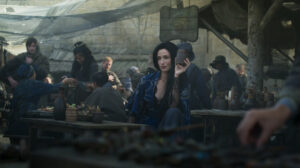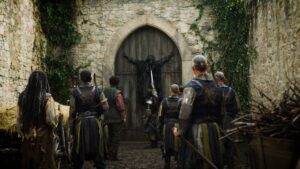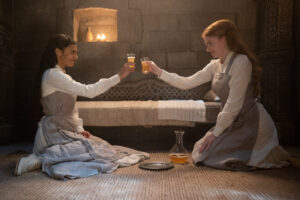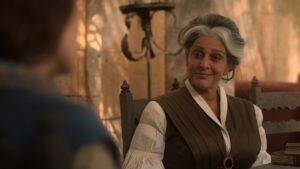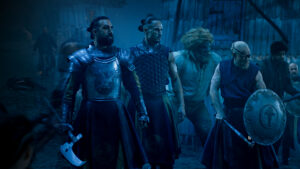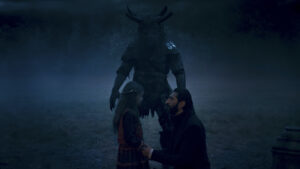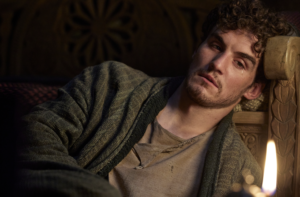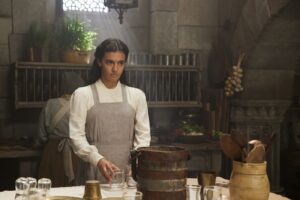MAJOR SPOILERS FOR THE WHEEL OF TIME, SEASON 2, EPISODES 1 – 3, AND BOOK 2, THE GREAT HUNT, AHEAD!
This piece was written during the 2023 WGA and SAG-AFTRA strikes. Without the labor of the writers and actors currently on strike, the series being covered here would not exist.
It’s fair to say that the first season of Amazon’s The Wheel Of Time was carried through its highs and lows by Rosamund Pike, the epic fantasy series’ Oscar-nominated star and producer. Not only was she front-and-center in all the marketing, her name alone a major draw for casual viewers unfamiliar with the acclaimed yet inaccessible source material (fourteen weighty novels and a prequel, published over the course of three decades by two authors), but in seven of eight episodes she was the clear lead amongst an underdeveloped ensemble cast, despite her character Moiraine being something of an enigma in the early books. While her young castmates had moments to shine, it was only in episode three that they had the run of the place to themselves, so to speak, while Moiraine was unconscious. It was New Zealand-born actress and relative newcomer Zoë Robins who stepped up then to fill her place, going above and beyond what was asked of her to earn her top-billing alongside Pike and Daniel Henney, two established stars. And in the second season, though all the cast have returned much stronger and more confident to their roles, it is Robins once again who tethers The Wheel Of Time to her perfect performance in a third episode that follows the pattern of sidelining Pike and Henney.
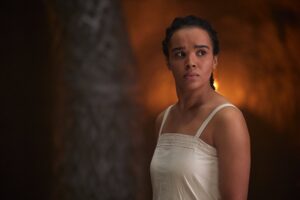
Pike and Henney may be the bigger stars, and Josha Stradowski may play the main protagonist of the books, but Robins is this adaptation’s beating heart, her soulful eyes the window through which we see most clearly all the workings of the world laid bare, because her Nynaeve al’Meara, while arguably even more likely than the other four villagers from the Two Rivers to reach some wildly wrong conclusion based on the limited information at her disposal and act on it before anyone can stop her, to be fair, is usually much closer to the truth of the matter than she has any right to be.
With a lesser actress in the role, I can easily imagine where this would become aggravating to watch, like one of those infuriating ads for a home-renovation mobile game that doesn’t resemble the actual game in the slightest, the ones where the “player” is presented with an extraordinarily simple problem yet somehow makes all the wrong choices and inevitably kills their character while all you can do is scream at the screen. It can still be like that, sometimes, watching Nynaeve metaphorically pick the sledgehammer to fix the bathroom sink, except that in her case, I know from the subtleties of Robins’ performance that it’s because Nynaeve has a relatable bad habit of deluding herself to the truth while simultaneously insisting that she couldn’t possibly be deluded, and not because she’s trying to make me download some generic match-three game.
Nynaeve is not one to be impressed by the artifices of the White Tower or the insufferable pageantry of its occupants, the Aes Sedai. She respects those who speak the truth plainly and mean what they say, no more, no less, so bending the truth without breaking it does not – and likely never will – come naturally to her. As a former Wisdom (the closest thing to an authority figure that existed back home in the Two Rivers), she particularly detests being made to feel like a pawn in all the ridiculously intricate mind-games Aes Sedai play at the Tower; a valuable pawn but a pawn nonetheless, to be used and cast aside by one woman, then another, as they all vie for higher seats in the Hall, with the ultimate goal of ascending to the Amyrlin Seat itself. And for all these reasons, The Wheel Of Time never made a better choice than when it paired Nynaeve up with the phenomenal Kate Fleetwood as Liandrin Guirale, an Aes Sedai of the Red Ajah who has had decades to practice the art of confounding young women by oscillating unpredictably between seeming like the least genuine person in the Tower and the most.
We don’t even see much of the masterful interplay between the two actresses in episode three, which opens with Nynaeve attempting the perilous Trial of the Arches alone and becoming trapped in a “mirror-world” for the entire duration of the episode, yet while Robins is occupied with selling Nynaeve’s growing desperation, Fleetwood, with a tremor in her proud jaw and a twitch of panic in her steely eyes, never allows us to forget that it was Liandrin’s ostensible confidence in Nynaeve’s abilities – and Nynaeve’s reluctant trust of Liandrin, formed through manipulation – that led her to this point. Whatever ulterior motive she may have had is irrelevant to her now as she watches this girl she’s come to regard with respect and pride be pulled apart, stitched back together, and thrown back into the meat-grinder in a ritual that will ultimately determine not whether she has what it takes to be Aes Sedai, but whether she is willing to sacrifice everyone and everything for the White Tower.
And in the first two mirror-worlds behind the silver Arches, Nynaeve heeds Sheriam Bayanar (Rima Te Wiata)’s repeated warning that “the way back will come but once” and successfully returns to the real world, at the price of abandoning her mortally wounded parents in one mirror-world and the disease-ridden population of the Two Rivers in another. But the callous attitude of the Aes Sedai enrages her as she heads into the third and final Arch, which leads her…straight back into what seems to be the real world, clinging to a blood-soaked lock of al’Lan Mandragoran (Daniel Henney)’s hair. Unable to remember what happened in the third Arch, she blows up at Liandrin and the other Aes Sedai, rejecting the Great Serpent Ring they offer her for completing the Trial and stating that she won’t be an Aes Sedai if it means turning her back on the people she loves. She says farewell to Egwene al’Vere (Madeleine Madden), leaves the Tower, and unexpectedly reunites with Lan, who takes her in his arms and assures her that they can go wherever she wants, together. And Nynaeve agrees, dismissing the small voice whispering urgently in her head that “the way back will come but once”, and the misty outline of the silver Arch dissipating swiftly behind her as she steps out of the Pattern, into a different life.
Meanwhile, in the real world, there is nothing that Liandrin, Sheriam, and Leane Sharif (Jennifer Cheon Garcia) can do but stare helplessly into the roiling depths of the third Arch, all three of them silently praying that they haven’t just gone and killed the most powerful channeler the Tower has seen in a thousand years, and probably wondering how they can cast the blame on each other…until the ter’angreal goes quiet and any chance of Nynaeve returning has disappeared. Leane skedaddles (she’s the Keeper of the Chronicles, she can’t be seen to have been involved in this debacle), Sheriam berates Liandrin and hurries away to clean up the mess, and Liandrin, in another disarming display of genuine affection for Nynaeve, stays behind, tears welling up in her eyes, before angrily flinging a clay pot on the floor and storming away in search of somebody she can take out her pain on, specifically Mat Cauthon (Dónal Finn), who barely has time to crack a joke before Liandrin is lacing into him with a monologue so scathing, so demeaning, and delivered with such brutal sincerity that Mat has no choice but to become a background character for the next two episodes.
What for Nynaeve feels like five or six years in the mirror-world is only about a day in the real world, yet even in that brief time the world comes close to falling apart without Nynaeve around. Liandrin leaves the door to Mat’s cell ajar and tells him to go find his friends or die in the Blight for all she cares, he makes a halfhearted effort to seek out Egwene and actually comes upon her crying for Nynaeve but turns away at the last moment and instead returns bashfully to his cell, where it falls on fellow prisoner of the Red Ajah Min Farshaw (Kae Alexander) to persuade him that being of little consequence to the Pattern is something to be envied, and that they should run off together…only for the audience to discover that Min is actually moving Mat out of Tar Valon at Liandrin’s explicit instruction. Egwene, distraught over Nynaeve’s death, refuses to be consoled by her new friend Elayne Trakand (Ceara Coveney), telling her “I don’t even know you!” as she slams a door in the Daughter-Heir’s face. She then seeks out Liandrin and actually channels at the far older and more experienced Aes Sedai – notably, without using her hands – but Liandrin effortlessly unravels her weaves of fire and only barely resists the urge to push Egwene off a balcony (forget the Last Battle, the Amyrlin Seat needs to do something about the lack of guard-rails at the White Tower).
Far west of Tar Valon, Perrin Aybara (Marcus Rutherford) and the Shienaran soldiers seeking the fabled Horn of Valere are made prisoners of the Seanchan Empire, whose representatives stand atop a pyramidal palanquin, wear fabulous scale-patterned robes, ornate masks and bladed fingernail covers, and speak with the most unnerving accent to hear in a high fantasy setting – a thick American Southern drawl. The Seanchan, we soon learn, are invaders from across the Aryth Ocean who have come to reclaim the lands that belonged by birthright to the founder of their mighty empire, Luthair Paendrag (everything from Toman Head in the west to the Spine of the World in the east). They could perhaps accomplish this goal with their massive armies, fleets, and the element of surprise alone, but they also have a…unique approach towards the use of the One Power, fastening unbreakable golden collars on women who can channel and leashing them to women called sul’dam who claim to be able to manipulate the use of the Power without dirtying their hands by touching the True Source. To the Seanchan, there is no distinction between an untrained channeler who believes she’s merely “listening to the wind” and an Aes Sedai, or between channelers of their land and another; there are only damane (those who have been collared) and marath’damane (those who will be collared).

The Seanchan claim the first major casualty of the season, fan-favorite Uno (Guy Roberts), who dies gorily but not without dignity, spitting at the feet of High Lady Suroth (Karima McAdams) – or as close to her feet as he can aim from the bottom of her pyramid – uttering The Wheel Of Time‘s first F-bomb, and having a large curved spike driven through his mouth shortly thereafter as an incentive for Perrin and the other Shienarans to swear the Seanchan oaths of fealty without further complaint. They wisely decide that mumbling something about obeying, awaiting, and serving is preferable to choking on a tusk, but instead of letting them go, Suroth has her new subjects chained and shipped off to Falme, the first major city captured by the Seanchan. Perrin is able to slip away from the convoy with Elyas Machera (Gary Beadle) and his wolf-pack, but what waits for him in the wilderness maybe worse than what’s behind, if Ishamael (Fares Fares), the Dark One’s right-hand man, is to be believed when he tells Perrin that his wolf-senses are derived from the Dark. It may seem counterintuitive to let Perrin escape, given that Ishamael is already posing as Suroth’s advisor, but he seems to care about letting people come to the Dark through their own choices, not through force.
It’s a more carefree version of Perrin who inhabits the mirror-world where Nynaeve found herself, and he’s not the only one of the Two Rivers folk for whom the ter’angreal has created something more pleasant than reality. Mat is a lord, by the looks of it, and quite dashing. Egwene is already an Aes Sedai of the Green Ajah. Nynaeve herself has returned to the Two Rivers, married Lan, and given birth to a daughter. Lan has grown out his hair (it looks terrible) and put down his sword. There’s no sign of Moiraine, conveniently, and the Last Battle must not have happened (yet), because everyone is happy. The highlight of this comforting sequence is seeing Rutherford and Finn play Perrin and Mat as two fun, dorky uncles to Nynaeve’s adorable daughter, and I’d be down for more exploration of mirror-worlds in the future if it allows the other actors to let loose a bit and play around with what might be – which is, fittingly, the title of the episode.
But this is The Wheel Of Time, and as I explained in my review of the previous episode, the titular Wheel doesn’t give many options to ta’veren, individuals like Nynaeve who are spun out into the Pattern to hold it intact. And the mirror-worlds are reflections for a reason – they may seem serene, some of them, but they are the versions of the world that the Wheel cannot allow to exist, where something went wrong: usually because someone made a choice that cannot happen in the real world without weakening the integrity of the Pattern, as I understand it. Nynaeve is meant to pass the Trial of the Arches and become Accepted, because she is meant to do…all of the things that she does later in the books that I won’t spoil here, but she can’t do any of them if she leaves the Tower now.
That doesn’t necessarily mean every version of the world where she leaves ends as this one does, with a horde of ravening Trollocs slaughtering Nynaeve’s friends and family before her eyes while she watches on, powerless to stop the carnage, but there’s no version of that world that results in the “official” triumph of the Light over the Dark at the Last Battle that the Wheel is turning towards in the real world, however it may have seemed to her in the Two Rivers. Already, she was hearing rumblings that Egwene was taking Aes Sedai north to the Borderlands to deal with incursions from the Blight. That version of Egwene will likely die and Trollocs will overrun the world without her, Nynaeve, Perrin, Mat, or Lan around to stop it. The people of that mirror-world could still conceivably defeat the Dark One – after all, they should still have a version of Rand al’Thor (Josha Stradowski) hanging about somewhere – but it will be a bleak and miserable world by the end, hardly worth saving.
Real world Rand, if you’re wondering, is busy tracking down an expensive bottle of red wine to bribe Logain Ablar (Álvaro Morte) into teaching him how to wield the One Power without going mad, which turns out to be a pointless endeavor because Logain is – surprise – already mad. The anticlimax is intentional and intriguing, though there were likely more effective methods by which we could have reached the same low-point in Rand’s arc where he feels time slipping through his fingers without us having to necessarily share the sentiment. At least there’s some fun to be gotten out of this slight diversion – Rand and Selene (Natasha O’Keefe) posing as outland lords to sneak into a fancy party; Rand unwittingly causing a commotion by throwing out invitation-letters from the great Houses of Cairhien; the subtle introduction of Moiraine’s younger sister Anvaere Damodred (Lindsey Duncan); and a fireworks-display, courtesy of Aludra and the Illuminators Guild. Rand isn’t enjoying any of it, however, and he leaves Selene to watch the fireworks by herself, which earns him an aggressive, sexually charged scolding later that night.
If there’s a version of Rand in Nynaeve’s picture-perfect mirror-world who’s any happier than the real world’s Rand (unlikely, seeing as he would still be the Dragon there, which pretty much guarantees that he’s traumatized and depressed), Nynaeve never met him and will never get the chance. Overcome with grief and rage unlike anything she’s felt before, she channels the One Power – something that is supposed to be impossible within the Arches – and wills the portal back into existence, years after it vanished. She can’t explain how she did it, Robert Jordan couldn’t explain how she did it when something similar happened in the books, and nor can I. Suffice it to say that Nynaeve is a force of nature, and although you’ve probably heard her referred to as “the strongest channeler the Tower’s seen in a thousand years” about as many times, it bears repeating. With her raw power and her determination to protect people, she can do the impossible, which is why breaking her block is crucial. If she can’t bring herself to channel until she’s angry or extremely sad, chances are someone she loves is going to have to die or get hurt in front of her before she can do anything to help.
And despite escaping the mirror-world, Nynaeve endures another terrible loss on the way back – that of her daughter, who survived the Trolloc attack only to disappear as Nynaeve staggered through the silver arches holding her close to her chest…the only trace of her a fresh bloodstain on the front of Nynaeve’s dress. Robins portrays the unimaginable horror and agony of this situation without reservation, her body contorting around the empty space that used to be her child, haunting screams issuing from her mouth while her eyes remain fixed on something ahead of her, something gone and soon to be forgotten. Memories of the mirror-world visited in the Arches fade quickly, like dreams, and the years Nynaeve spent in the Two Rivers with Lan, raising her daughter, will blur together. In time, she’ll only remember with certainty that she once remembered something more.

As The Wheel Of Time inches closer to adapting the lengthy sections of the source material that feature very little of either Pike or Henney’s characters, it is an encouraging sign for the series’ future that the ensemble cast surrounding them are now not only capable of carrying episodes on their own, but that a few like Robins and Fleetwood have been hailed as the season’s shining stars. The outstanding performances they deliver may not earn them any Emmy nominations, because awards show voters tend to overlook the fantasy genre entirely unless it has the Game Of Thrones title attached (and even House Of The Dragon received fewer nominations than were arguably warranted), but they have accomplished something greater than any trophy could honor, bringing The Wheel Of Time‘s most iconic characters to life. “It was about them all”, reads a famous and enduring quote from the books. That has never felt more true of the show than it is now.
Episode Rating: 9.5/10
